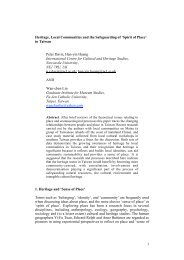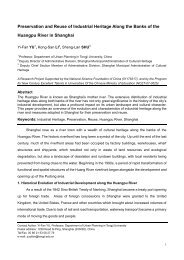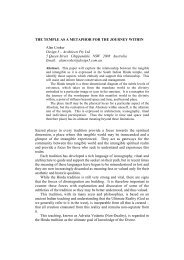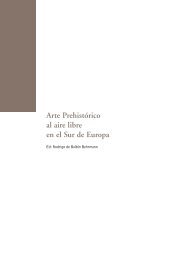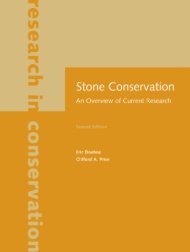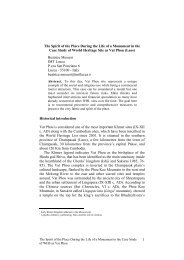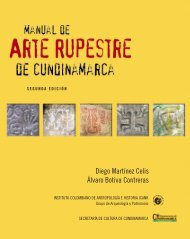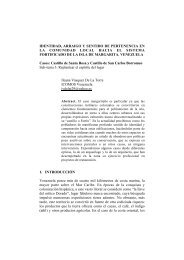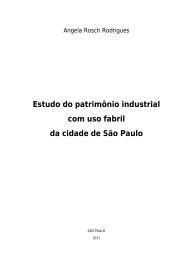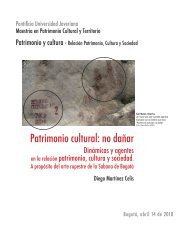La définition d'une stratégie d'intervention - ICOMOS Open Archive
La définition d'une stratégie d'intervention - ICOMOS Open Archive
La définition d'une stratégie d'intervention - ICOMOS Open Archive
Create successful ePaper yourself
Turn your PDF publications into a flip-book with our unique Google optimized e-Paper software.
<strong>La</strong> définition d’une stratégie d’intervention.<br />
<strong>La</strong> definición de una estrategia de intervención<br />
Defining a strategy for intervention<br />
architecture”, thanks to these hidden human links better physical forms<br />
and social behaviors are achieved.<br />
Coderch intends “to learn” from the vernacular sociophysical chronotope.<br />
That is, the view from the top, the inside-outside vernacular window,<br />
the public life in the narrow street and the “minimal” building elements,<br />
wood and white walls, and colors that mixes ships and houses. The<br />
“modesty” of the renewal obtained paradoxically an “avant-garde”<br />
modern tone.<br />
It is not a “Beaux Arts” copy of the vernacular, but a “modern” chronotope<br />
(abstract relationships, and dynamic composition) that “plays” with<br />
the vernacular features, without destruction of the urban form and<br />
domestic character.<br />
It was a lesson for the future.<br />
In nineteen seventy the Catalan architect Magda Saura followed this<br />
lesson by Coderch and enlarged the “narrative” with new chronotopic<br />
structures coming from California and from Le Corbusier heritage.<br />
The vernacular house maintains all the characters “in dialogical” attitude<br />
with a new domestic modern view. This “dialogical” attitude between<br />
the old and the new, both in relation to the physical and the social<br />
dimensions of architecture, is, according to Mikhail Bakhtin the kernel of<br />
the chronotope in the genre of the novel. The house arrives to combine<br />
two life-styles separated in time but articulated in the same space.<br />
There is a dense “feed-back” between history and design. In order to be<br />
able to build this “feed-back” the architect had to be enthusiastic both<br />
with history and with modern design. As I said above this is pitifully<br />
rare, because of the strong prejudgments against the possibilities of<br />
this potential “dialogue” in architecture.<br />
In nineteen ninety-two, the same architect coordinated the complex<br />
design of a waterfront in Empuries where the Olympic Flame arrived in<br />
the same year to Catalonia.<br />
This landscape design was “dialogical” too, and was published in the<br />
review Quaderns by the Catalan Association of Architects.<br />
It is important to point out the significance of the renewal of landscapes<br />
in order to be able to renew vernacular architecture: they go hand<br />
by hand. Either they are both protected or they are both destroyed.<br />
There the dunes, the threes and the Greek ruins play the role that<br />
walls, windows and roofs play in architecture, but the key chronotopic<br />
sociophysical features have a key role here too.<br />
The waterfront wooden way “optimizes” the experience of the historical<br />
and geographic context, making sociophysical relationships between<br />
dunes, sea, ruins and vegetation alive. Users feel this chronotopical<br />
richness and are grateful for that. A web of relations is in the air. You<br />
need only to walk and to breathe to notice it.<br />
3. The “Vernacular” and the “Modern” Chronotope<br />
In recent works 9 I have developed a “dialogical” view of architectural<br />
design, where the key concept of chronotope created by the founder<br />
of this theoretical trend, the Russian intellectual Mikhail Bakhtin,<br />
occupies a privileged place 10 . A chronotope is a link between objects<br />
and subjects, that is, between physical (cosmic) space and time, and<br />
social (historical) space and time. This concept is used by Bakhtin in<br />
the analysis of literary works. For example the development of the<br />
novel since classical Greek time until now, some two thousand and five<br />
hundred years later.<br />
The vernacular chronotope is basic for Bakhtin, because it is the first step<br />
in any artistic human development. It has an enormous richness and it<br />
is an inexhaustible source of feelings, stories, personages, etc. However,<br />
wrote Bakhtin with his proverbial irony: “the vernacular chronotope<br />
has only one defect: it never changes.” So the modern chronotope is<br />
on the contrary, very dynamic and changes all the time, but often has<br />
no content, only form. The complementarity we have seen between<br />
vernacular and modern architecture has the same characteristics<br />
defined by Bakhtin, as was already pointed out by the architect and<br />
famous historian Sigfried Giedion in his last and posthumous book:<br />
Architecture and the Phenomena of Transition, 11 where he defines the<br />
evolution of architectural design in Europe throughout chronotopic<br />
sociophysical basic changes. See diagram IV below as an example of<br />
the value of historical urban planning.<br />
Visual network in the Middle Ages in the south of France. This network<br />
is the reason of the “order” we see in the vernacular architecture. Doors<br />
and windows follow this invisible web of visual interrelationships. If we<br />
need to destroy this order, at least, we should be able to build a better<br />
one.<br />
In conclusion, modernity can be either the end of vernacular<br />
architecture in the Mediterranean area or, on the contrary, can be the<br />
best way for renewal. It depends upon political, economic and cultural<br />
attitudes, which, for the moment are still oriented towards destruction.<br />
However ecological new developments (climate changes) and new<br />
social cultural attitudes can slowly change this orientation, as late<br />
professor Lewis Mumford wrote to me in a last letter before his death,<br />
where he argued about the new ecological awareness among young<br />
students in USA: “a new hope”.<br />
I hope so too.<br />
1 See review Arquitectura 63. School of Architecture. Barcelona, 1963.<br />
2 Very important the book by Martha Pollack The Architect. MIT Press.<br />
3 See Muntañola, J. <strong>La</strong> Topogénèse. Anthropos. Paris, 1997. (Spanish text in <strong>La</strong> Topogénesis.<br />
UPC Edicions. Barcelona, 2000.<br />
4 See too. Rapoport, A.<br />
5 I do not mean that Franco dictatorship was better than a democracy. Democracy<br />
should be able to combine modernity and renewal of historical urban form, in a<br />
complementary way. Pitifully, in Spain, this has not been the case. Speculation made<br />
this impossible.<br />
6 See . Chapter 10. Lewis Mumford sent to me the Spanish version of<br />
the book.<br />
7 This is the reason of the International Review Arquitectonics (See the web www.<br />
arquitectonics.com.<br />
8 See (Muntañola, J. editor). School of Architecture in Barcelona<br />
Proceedings 4th International Congress in Barcelona in June 2004.<br />
9 See Muntañola, J. . (Volume I).<br />
Editorial Abecedario. Badajoz, Spain, 2007.<br />
10 See by Josep Muntañola in the series Arquitectonics.<br />
11 See Architecture and the Phenomena of Transition by S. Giedion. I wrote the introduction<br />
of the Spanish translation of this posthumous work in 1972. (Gustavo Gili. Barcelona).<br />
151



